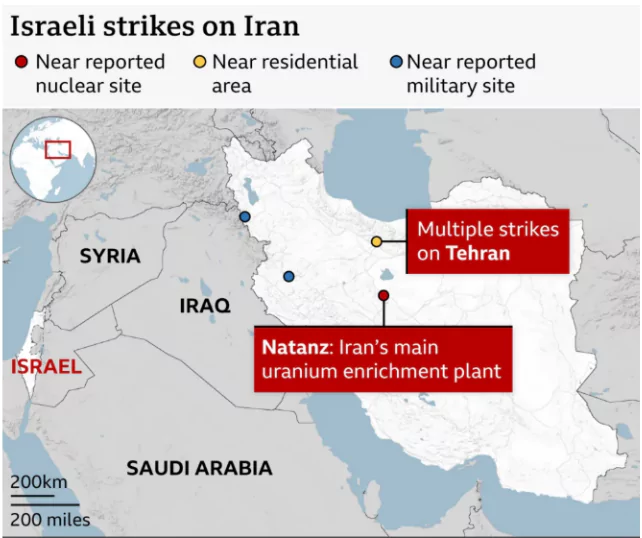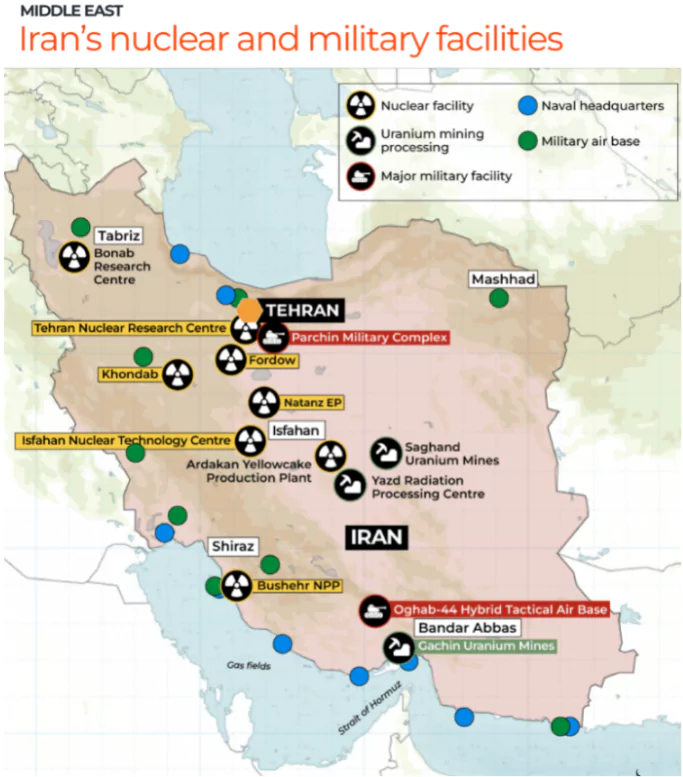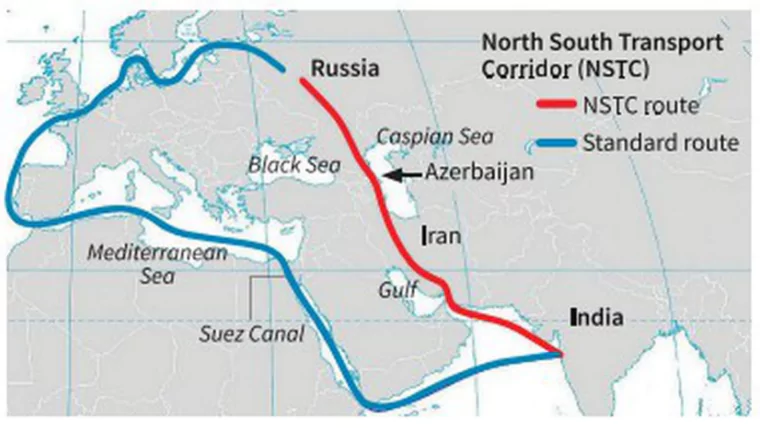Israel has launched ‘Operation Rising Lion’ to prevent Iran from building nuclear weapons targeting its nuclear facilities, missile bases.
- Key Casualties: Hossein Salami (Iran’s IRGC chief) and two top nuclear scientists.
- Iran responds with ‘Operation True Promise 3’ after the Israeli attack.

About the Nuclear Programme of Iran
- The IAEA warns that Iran is now “the only non-nuclear-weapon state producing such material”, calling it a “serious concern.”
- The IAEA report confirms that Iran did not declare nuclear material and activities at three sites: Lavisan-Shian; Varamin; Turquzabad.
- These locations were part of an undeclared nuclear program active until the early 2000s.
- The report comes amid ongoing U.S.-Iran talks over a possible nuclear deal.
Uranium Enrichment
- Uranium enrichment is the process of increasing the concentration of the uranium-235 (U-235) isotope in natural uranium.
- It is done to make it suitable for use as fuel in nuclear reactors or, at higher enrichment levels, in nuclear weapons.
- Natural Uranium Composition: Natural uranium consists mostly of U-238 (99.3%) and only 0.7% U-235.
- U-235 is fissile, meaning it can sustain a nuclear chain reaction, while U-238 is not.
- Enrichment Levels:
- Low-enriched uranium (LEU): 3–5% U-235 (used in most nuclear power reactors).
- Weapons-grade uranium: 90% or more U-235 (used in nuclear bombs).
- Non-Proliferation Concerns: Uranium enrichment is closely monitored because it can be used for both peaceful (energy) and military (weapons) purposes.
|
Iran–Israel Relations: Background & Timeline
Phase I: Strategic Cooperation (1948–1979)
- 1948: Iran did not recognize Israel officially, but did not join Arab-Israeli wars.
- 1950s: Iran quietly aligned with Israel under Ben-Gurion’s “Periphery Doctrine” — alliance with non-Arab states (Iran, Turkey, Ethiopia) to counter Arab hostility.
- 1958: Formation of “Trident” intelligence pact (Iran–Israel–Turkey); joint operations against Baathist Iraq.
- Post-1967 War: Despite rising criticism in the Muslim world, the Shah of Iran maintained relations with Israel.
 1970s: Secret energy and military cooperation peaked:
1970s: Secret energy and military cooperation peaked:-
- Oil pipeline projects (Eilat–Ashkelon).
- Project Flower: Joint missile R&D initiative.
- Arms sales and Israeli technical assistance flourished.
Phase II: Ideological Confrontation (Post-1979)
- 1979 Islamic Revolution: The Shah was overthrown; the Islamic Republic of Iran was established under Ayatollah Khomeini.
- Iran severed all ties with Israel and handed its embassy in Tehran to the Palestinian Liberation Organization (PLO).
- Israel was labeled the “Little Satan”, USA the “Great Satan”.
- 1980s: Paradoxical Relations: Despite hostility, Israel supplied weapons to Iran during the Iran–Iraq War:
-
- Iran-Contra Affair (1985–86): Covert US-Israel-Iran arms-for-hostages deal.
- Both countries opposed Saddam Hussein and viewed Iraq as a bigger threat.
Phase III: Shadow War & Nuclear Tensions (1990–2020)
- Iran emerged as a key backer of Hezbollah (Lebanon) and Hamas (Gaza) — both anti-Israel militant groups.
- Iran was suspected of developing nuclear weapons. Israel viewed this as an existential threat.
- Cyber warfare era: Israel and the US launched Stuxnet virus on Iran’s Natanz facility (2010).
- Covert operations: Multiple Iranian nuclear scientists were assassinated (e.g., Mohsen Fakhrizadeh, 2020).
Phase IV: Escalation & Open Conflict (2020–2025)
- 2021–2023: Proxy escalation: Iran’s proxies — Houthis, Hezbollah — stepped up attacks post-Gaza conflict.
- Israel responded with targeted assassinations in Lebanon and Syria.
- April 2024: Iran launches 300 drones and missiles on Israel after its consulate was bombed in Damascus.
- Israel retaliated with strikes on Iranian anti-aircraft systems and IRGC facilities.
- June 2025 – Operation Rising Lion
- Israel launched open military strikes on Iran, targeting:
- Natanz nuclear site
- IRGC command chain
- Nuclear scientists
- Iran responded with missile and drone retaliation, no major Israeli casualties reported.
- IAEA censured Iran for secret enrichment; Iran threatened NPT withdrawal.
About International Atomic Energy Agency
- Establishment & Purpose: Founded in 1957 to promote peaceful use of nuclear energy while preventing its misuse for weapons.
- Acts as the global watchdog for nuclear non-proliferation.
- Headquarters: Based in Vienna, Austria.
- Total Membership: 180 (as of 15 November 2024)
- India has been a member of IAEA since its inception in 1957.
- Functions:
- Implements legally binding agreements to monitor nuclear activities.
- Conducts inspections to verify compliance with the Nuclear Non-Proliferation Treaty (NPT).
- Sets global standards for nuclear safety (e.g., power plants, radiation protection).
- Helps prevent nuclear terrorism by securing radioactive materials.
- Awards: Won the 2005 Nobel Peace Prize for efforts to prevent nuclear military use.
- Key Treaties: NPT (Non-Proliferation Treaty) and Comprehensive Nuclear-Test-Ban Treaty (CTBT).
Non-Proliferation Treaty (NPT)
- It is an international agreement aimed at:
- Preventing the spread of nuclear weapons and weapons technology.
- Promoting peaceful uses of nuclear energy.
- Advancing global nuclear disarmament.
- The NPT was opened for signature in 1968 and entered into force in 1970.
- NPT recognizes five official nuclear-weapon states: United States; Russia (formerly USSR); United Kingdom; France; China.
- These countries had built and tested nuclear weapons before January 1, 1967.
- India, Pakistan, and Israel never signed the treaty and possess nuclear weapons.
- North Korea withdrew from the NPT in 2003 and has allegedly developed nuclear weapons.
|
Why Did Israel Attack Iran?
- Prevent Iran from Acquiring Nuclear Weapons
- Existential Threat: Israel views a nuclear-armed Iran as an existential danger, given Iran’s repeated threats (e.g., “wiping Israel off the map”).
- Enrichment Escalation: Iran had enriched uranium to 60% purity (close to weapons-grade 90%).
- Failure of Diplomacy: U.S.-Iran talks (mediated by Oman) stalled over Iran’s refusal to halt enrichment.
- Exploit Iran’s Weakened Regional Position
- Proxy Wars: Iran’s allies (Hamas, Hezbollah, Houthis) were weakened after Israel’s Gaza war (2023–25) and Syria’s regime collapse (2024).
- Diminished Deterrence: Israeli strikes in October 2024 degraded Iran’s air defenses.
- Assassinations of IRGC/Quds Force leaders reduced Iran’s retaliatory capacity.
- Immediate Trigger: IAEA’s Non-Compliance Resolution
- On June 12, 2025, the IAEA Board declared Iran in breach of its nuclear safeguards—the first such censure in 20 years.
- The resolution accused Iran of hiding nuclear activities at three sites (Lavisan-Shian, Varamin, Turquzabad).
- Israel saw this as a green light for military action before “snapback” sanctions (expiring October 2025).
- Domestic Politics in Israel
- Netanyahu’s Survival: Facing corruption charges and coalition instability, Netanyahu framed the attack as critical for Israel’s security.
- Public Support: Opposition leaders (e.g., Yair Lapid) backed the strikes, uniting Israelis amid political turmoil.
- Broader Strategic Goals
- Decapitate Iran’s Nuclear Program: Target scientists, centrifuges, and enrichment sites (Natanz, Fordow).
- Deter Future Attacks: Demonstrate Israel’s ability to strike deep inside Iran.
- Regional & Strategic Calculus
- Iran’s Proxy Network: Iran has trained and armed Hezbollah, Hamas, Houthis — all active against Israel.
- Israel aims to cut the head off the snake by directly targeting Iran rather than its proxies.
- Collapse of US Restraint: Despite US President Trump’s warnings to avoid escalation, he later supported Israel and warned Iran to “make a deal before there’s nothing left”.
- Shift from Covert to Overt War: Unlike previous sabotage operations (Stuxnet, assassinations), this was an open military operation, signaling a doctrinal escalation.
About Hezbollah
- Hezbollah, meaning ‘Party of God,’ is a Shiite Islamic militant organization based in Lebanon.
- Founded during the Lebanese Civil War (1975-1990) amid ethnic and religious tensions.
- Inspired by the Iranian Islamic Revolution (1979) and supported by Iran’s funds and training.
- Main goals include opposing Israel, Western influence in West Asia, and supporting the Syrian government during its civil war.
About Hamas
- It is the largest Palestinian militant Islamist group and a significant political party in the region.
- Formation: Founded in the late 1980s during the first Palestinian intifada (uprising) against Israeli occupation, Hamas emerged from the Palestinian Muslim Brotherhood.
About Houthis
- The Houthi movement, also known as Ansarallah (Supporters of God), is one side of the Yemeni civil war that emerged in the 1990s under its leader, Hussein al-Houthi.
- Ideology: Al-Houthi launched “Believing Youth,” a religious revival movement for a centuries-old subsect of Shia Islam called Zaidism. The followers of Al-Houthi are termed ‘Houthis’.
- External Influence: Houthis are deeply influenced by the Lebanese Shia political and military organization Hezbollah, and they adopted their official slogan against the United States, Israel, and the Jews.
|
Geopolitical Implications of Israel’s Strikes on Iran
- Escalation of Regional Instability in West Asia: Israel’s strikes risk triggering a broader conflict involving Iranian proxies like Hezbollah (Lebanon) and the Houthis (Yemen), potentially igniting multi-front war scenarios.
- Collapse of Iran Nuclear Diplomacy: The strikes followed an IAEA resolution declaring Iran non-compliant with its NPT obligations. Israel acted preemptively, sabotaging upcoming nuclear talks in Muscat.
- The Muscat-hosted 6th round of talks was called off, and Iran threatened to withdraw from the NPT, ending global oversight of its nuclear program.
- Threat to Global Oil Supply via Strait of Hormuz: Iran may retaliate economically by blocking or mining the Strait of Hormuz, through which 20% of global oil passes.
- In 2019 and 2022, Iran-backed groups previously targeted oil tankers in the Gulf. A repeat could push crude prices beyond $100/barrel, affecting global inflation.
- Iran has 2.8 million barrels per day (b/d) total refining capacity (2.2M crude + 0.6M condensate), produced ~4M b/d in May, but exports may drop below 1.5M b/d.
- Erosion of International Norms and Deterrence Frameworks: Israel’s unilateral strikes—outside UN sanction—challenge non-proliferation architecture, weakening the role of the IAEA, JCPOA, and even the UNSC.
- Israel’s 1981 Osirak (Iraq) strike was justified by the Begin Doctrine. In 2025, it used the same logic against Natanz without global consensus.
- US Strategic Ambiguity and Repercussions: Despite initial opposition, President Trump issued post-strike threats to Iran, signaling tacit US support and risking deeper entanglement in West Asia.
- “Trump warned Iran: ‘Make a deal or there’ll be nothing left.’” This signals a shift from diplomacy to coercion.
- China’s Position and Role as Mediator at Risk: China brokered the Iran–Saudi détente in 2023. A prolonged Israel–Iran war undermines its credibility as a neutral peace-broker and disrupts BRI oil corridors.
- China is Iran’s top oil importer; 25% of its oil passes through unstable West Asian sea routes.
- Risk of Multi-Theatre War via Proxy Networks: Iran could activate dormant proxy fronts to retaliate, including cyberattacks, drone warfare, and assassinations, turning the region into a web of low-intensity conflicts.
- The 2021–2023 Israel–Hamas–Hezbollah standoff resulted in over 100 rocket strikes within 72 hours, despite no direct state-to-state war.
Risk of Nuclear Disaster in the Israel–Iran Conflict
- Iran’s Enrichment Breach and NPT Breakdown: Iran was enriching uranium to 60% purity as of early 2025, and the IAEA censure resolution (June 12, 2025) triggered Israel’s pre-emptive strike.
- Iran retaliated by threatening withdrawal from the NPT, raising the risk of it developing a nuclear weapon without international safeguards.
- Israel’s Targeting of Iran’s Nuclear Infrastructure: Israel bombed key nuclear sites including Natanz and Fordow, both housing advanced centrifuges.
- These attacks risk triggering nuclear fallout, either through sabotage accidents or damage to underground enrichment chambers.
- Stuxnet Legacy and Sabotage Risks: The precedent of Stuxnet (2010)—a cyber weapon deployed jointly by Israel and the US—already proved the region’s vulnerability to digital sabotage of nuclear systems.
- Chain Reaction of Pre-Emptive Doctrines: Both countries now operate under pre-emptive doctrines:
- Israel’s Begin Doctrine justifies first strikes against nuclearizing enemies.
- Iran now argues self-defence as a rationale to go nuclear if attacked.
- Breakdown of Deterrence Architecture: The erosion of IAEA credibility, halted diplomacy, and absence of a JCPOA-like cap means no verification or red lines remain, increasing chances of miscalculation.
- Global Fallout and Regional Arms Race: Saudi Arabia, Turkey, and Egypt may now reconsider nuclear weapon options, fearing a nuclear Iran or region-wide war.
- A single accident or radiation leak could cause Chernobyl-scale devastation in West Asia.
Importance of Israel for India
- Major Defence Partner: Israel is one of India’s top three arms suppliers.
- Key exports include: SPICE bombs, Heron drones, surveillance systems, and missile defense systems.
- Technology & Innovation Collaborator: Strong cooperation in homeland security, cybersecurity, and agriculture technologies.
- Israel’s niche innovations in AI, water management, and electronics are being integrated into Indian systems.
- Balanced Bilateral Trade: Total bilateral trade in goods was over $6.35 billion in 2021–22, excluding defence.
- Trade includes diamonds, chemicals, electronics, and agri-products.
- Intelligence and Counterterrorism Support: Israel provides India with critical assistance in counter-terror operations, border surveillance, and intelligence gathering.
- Strategic Convergence in West Asia: India sees Israel as a partner in Indo-Abrahamic diplomacy (India–Israel–UAE).
- The two share similar threat perceptions from regional instability in Iran and beyond.
Importance of Iran for India
- Chabahar Port: Strategic Access Point: Iran hosts the Chabahar Port, giving India direct access to Afghanistan, Central Asia, and Russia, bypassing Pakistan.
- India signed a 10-year Chabahar Port operation deal in May 2024, crucial for India’s Eurasian outreach.
- Connectivity via INSTC: Iran is central to the International North–South Transport Corridor (INSTC), reducing freight costs and shipping times to Europe.
- INSTC is described as “India’s most ambitious overland Eurasian connectivity route.”
- Energy Security Partner (Pre-Sanctions): Iran was a major crude oil supplier, offering rupee-based trade and discounts until US sanctions disrupted imports in 2019.
- Suggests that resumption of energy ties depends on US lifting secondary sanctions.
- Strategic Counterbalance to China: India’s presence in Iran offsets growing Chinese influence following the 25-year Iran–China strategic pact.
- China’s interest in linking Chabahar with Gwadar; India’s engagement with Iran helps prevent this.
- Diplomatic Leverage in Islamic World: Despite divergences (e.g., Iran’s stance on Kashmir), Iran is part of India’s civilizational and regional diplomacy strategy in the Islamic world.
- Describes Iran as “a cultural bridge in India’s West Asian diplomacy,” especially useful during crises like Gaza.
About International North-South Trade Corridor (INSTC)

- The INSTC was initiated in 2000 by Russia, India and Iran, is a multi-modal transportation route linking the Indian Ocean and the Persian Gulf to the Caspian Sea via Iran, and onward to northern Europe via St Petersburg in Russia.
- INSTC consists of sea routes, rail links, and road connections that connect Mumbai in India to Saint Petersburg in Russia, passing through Chabahar.
- Member Countries: It has been ratified by 13 countries namely, Azerbaijan, Belarus, Bulgaria, Armenia, India, Iran, Kazakhstan, Kyrgyzstan, Oman, Russia, Tajikistan, Turkey, and Ukraine.
- The corridor has several branches:
- On the western side of the Caspian Sea, it would link Russia to Iran through Azerbaijan.
- The eastern branch runs along the eastern coast of the Caspian Sea and links the main corridor to different road and rail networks of Central Asian countries such as Turkmenistan and Kazakhstan.
|
Implications and Challenges for India
- Strained Strategic Balancing Between Two Adversaries: India’s deep defence and technology ties with Israel (over $6.5 billion trade) clash with its energy and connectivity interests in Iran (Chabahar Port, INSTC).
- Open hostilities force India into a diplomatic tightrope walk, risking alienation from both Israel and the Islamic world, especially amid OIC scrutiny and NAM dynamics.
- Setback to Chabahar and INSTC Vision: India’s 10-year Chabahar Port operation deal (May 2024) may be jeopardized by regional instability.
- The broader International North–South Transport Corridor (INSTC), essential for bypassing Pakistan and accessing Central Asia and Russia, faces logistical and security risks.
- Oil Supply Disruptions and Import Bill Spike: A war-induced disruption in the Strait of Hormuz could sharply impact India’s economy.
- With over 80% of oil imported, even a $10/barrel crude price rise could increase India’s import bill by ~$15 billion, worsening inflation and the current account deficit.
- The Strait of Hormuz is a vital chokepoint for Qatar’s LNG exports, a key supplier to India.
- Threat to Indian Diaspora and Trade Routes: India’s ~9 million-strong diaspora in West Asia is vulnerable to regional conflict.
- Missile strikes or blockades could disrupt remittances, shipping lanes, and require emergency evacuations, as seen during Operation Kaveri (2023) and COVID repatriations.
- Disruption of Rupee–Rial Trade and Infrastructure Investments: Sanctions and war will shrink the $2.11 billion India–Iran trade corridor and stall long-pending railway and port infrastructure projects.
- India’s non-dollar oil purchases and regional presence risk collapse amid escalating instability.
- Compromised West Asia Diplomacy and Geopolitical Role: India’s aspirations to emerge as a neutral peace-broker or link between Israel and the Islamic world face serious erosion.
- Strengthening the India–Israel–UAE axis could alienate Iran, while visible neutrality might irk Israel and the US.
- Pressure to Recalibrate Defence Imports and Strategic Posture: Supply chain risks due to prolonged conflict may disrupt Indo-Israel co-development projects like the Heron drone program and LRSAM systems.
- India must accelerate Atmanirbhar Bharat in defence and prepare for realignment if US–Iran hostility intensifies or if China deepens its Iran presence via Gwadar–Chabahar corridors.
Way Forward for India Amid Israel–Iran Conflict
- Adopt a Calibrated, Neutral Diplomatic Posture: India should neither endorse Israeli strikes nor condemn Iranian retaliation, but call for de-escalation and uphold principled neutrality.
- India avoid “aligning too closely with either camp” and instead maintains a multi-alignment strategy that protects both connectivity and defence ties.
- Use Strategic Platforms for Regional Dialogue: India should leverage its role in SCO, BRICS, and the I2U2 (India–Israel–UAE–US) grouping to act as a moderating force and push for diplomatic resolution.
- Iran’s recent BRICS membership, supported by India, creates new platforms for India to engage Tehran constructively.
- Fast-Track Chabahar and INSTC Operationalization: Despite tensions, India must proceed with its 10-year Chabahar Port agreement and accelerate INSTC shipments to assert its economic footprint in Iran.
- Maintaining operational control at Chabahar during regional crises enhances India’s geopolitical credibility.
- Diversify Energy Sources and Push for Waivers: India should lobby for US-led sanction waivers to resume limited oil imports from Iran, while simultaneously diversifying suppliers to reduce dependency.
- Engaging in creative diplomacy to “protect energy security and ensure competitive crude pricing”.
- Strengthen Indigenous Defence and Tech Cooperation with Israel: Continue co-development of missile systems (like Barak-8), drones, and AI in defence with Israel, but localize production to reduce geopolitical supply risks.
- Expanding tech partnerships while improving self-reliance in defence R&D.
- Prepare Evacuation & Trade Route Contingency Plans: India should be ready with emergency evacuation protocols for its diaspora in West Asia and pre-identify alternative maritime corridors in case of Gulf escalation.
- Gulf shipping lanes may be disrupted by Iranian retaliation, requiring India to prepare alternatives for crude and container routes.
Conclusion
The Israel-Iran conflict poses significant challenges for India, threatening energy security, diaspora safety, and strategic interests like Chabahar Port. India must adopt a neutral diplomatic stance, diversify energy sources, and strengthen indigenous defense capabilities to navigate this volatile geopolitical landscape effectively.
![]() 14 Jun 2025
14 Jun 2025


 1970s: Secret energy and military cooperation peaked:
1970s: Secret energy and military cooperation peaked: